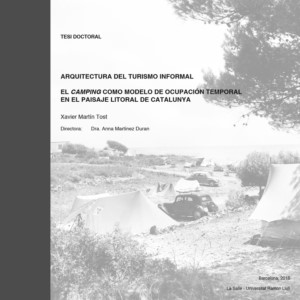Mr. Xavier Martin’s Thesis Lecture

Author: Martín Tost, Xavier
Director: PhD. Martínez Duran, Anna
Date: 17th of September 2018
Tribunal: PhD. Ferrer Aixalà, Amador; PhD. Sauquet Llonch, Roger Joan; PhD. Musquera Felip, Sílvia.
Abstract:
Campsites are a tourist model based on the Humanity’s most primitive way of inhabiting nature: nomadism. The nomads are placed on the soil without physically altering it, but providing it with meanings that establish links with the occupied places: both in the journey, and in the relax. The moving habitat is originated from the need to find shelter and food. But also from the desire to discover cultures or places, and to interact with them in a playful and active way. Landscape, Architecture and Tourism are the three axes in which this research is articulated around the typology of campsites.
Living in holidays intensifies both leisure in nature and social relations between the people, so it allows to experiment with new forms to inhabit in community. These groupings imply two levels of participation: on the one hand, the establishment of the settlement in its context, a previous organization that guides the support of the activities in relation to the environment; and, on the other one, the users’ particular adaptation through the use of light and transportable accommodations. Thus, architecture sets the game board: the physical rules which may facilitate the temporary shelter of the inhabitants, with minimal and precise occupations on the inhabited place.
In the middle of the 20th century, an opening took place in Spain. This event promoted mass tourism as a booming industry, and which caused the transformation of the landscape of its coasts. One of the most representative territories was the littoral of Catalonia, which became the gateway from Europe and the area with the highest concentration of campsites in the country. With a concern for the new ways of living offered by tourism, the architects used this unprecedented field to experiment with innovative solutions, respectful of nature and based on an interpretation of local tradition by means of Modernity. Due to the quality and diversity of the proposals, and their evolution to the present, in this thesis are analysed five paradigmatic cases through a comparative approach from three different scales of action: The Temporary City -implantation-, The Open Building -architecture- and The Itinerant Habitat -user-.
In order to recognize the qualities of these unique architectures, the research aims to raise their original values as sustainable settlements, based on an informal, temporary and respectful occupation of Nature. And, furthermore, it is aimed to pose its possibilities to become a paradigm of landscape conservation, urban regeneration and social interaction between the individual and the community.
